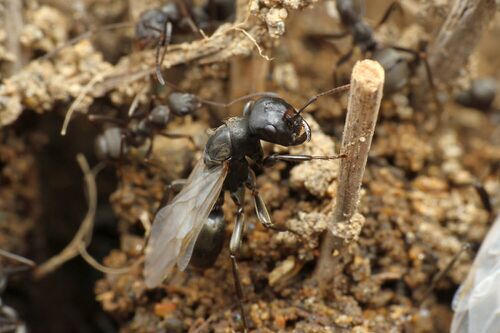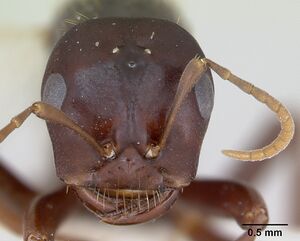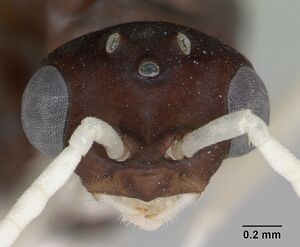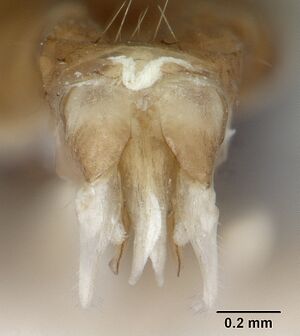Polyergus samurai
| Polyergus samurai | |
|---|---|

| |
| Conservation status | |
| Scientific classification | |
| Kingdom: | Animalia |
| Phylum: | Arthropoda |
| Class: | Insecta |
| Order: | Hymenoptera |
| Family: | Formicidae |
| Subfamily: | Formicinae |
| Tribe: | Formicini |
| Genus: | Polyergus |
| Species group: | samurai |
| Species: | P. samurai |
| Binomial name | |
| Polyergus samurai Yano, 1911 | |
| Synonyms | |
| |
| Common Name | |
|---|---|
| Samurai-ari | |
| Language: | Japanese |
Polyergus samurai is dulotic with Formica japonica as its main host along with Formica hayashi occasionally. A colony with both Formica fukaii and F. japonica as slaves has been observed on Mt. Zao, Miyagi Prefecture (Sonobe, unpublished); this seems to be a rare occurrence. P. samurai nests in the soil and is seldom seen on the ground except when slave-raiding. Raids are carried out at around 3 to 4 pm during summer, when cocoons of slave species are to be found. Hasegawa & Yamaguchi (1995) reported the detailed ecology and raiding behavior of this species. Less common in Shikoku and Kyushu than elsewhere. Nuptial flights occur around July. Chromosome number n = 27 (Crozier, 1970) (Japanese Ant Image Database). Within its range it is the lone Polyergus species. Polyergus samurai is better known from studies of Japanese populations and is relatively poorly studied where it occurs in mainland Asia.
| At a Glance | • Dulotic • Ergatoid queen |
Photo Gallery
 Polyergus samurai queen leaving her nest for her nuptial flight. Japan. Photo by Taku Shimada.
Polyergus samurai queen leaving her nest for her nuptial flight. Japan. Photo by Taku Shimada.
Identification
There was only minor variation among individuals detected among the specimens studied. Wheeler (1927) noted that the Chinese population he described as the subspecies mandarin was possibly blacker than the Japanese population. However, a small sample of workers from Beijing I obtained during this study had coloring indistinguishable from Japanese samples, and photographs sent to me of worker and male specimens from Hebei look typical, including the starkly white appendages of the male.
Polyergus samurai is probably not sympatric with any other species. It is easily distinguished from most other Polyergus species by its dark brown color, appearing nearly black in the field. It is closest to Polyergus nigerrimus, a smaller, darker, shinier species that lives in arid regions to the west of the range of samurai. Polyergus samurai males are notable for their striking white wings (even the veins are very pale yellow), and whitish appendages, including the mouthparts. Gynes also have white wings, with pale brown veins, and partially light brown appendages. This is in contrast to the dark brown appendages, brownish veins and infuscation of the wings of both sexes of nigerrimus.
Keys including this Species
Distribution
This species occurs in humid temperate Asia: Japan, Korea, China and southeastern Russia (teste Kupyanskaya 1990).
Latitudinal Distribution Pattern
Latitudinal Range: 38.283333° to 30.359°.
| North Temperate |
North Subtropical |
Tropical | South Subtropical |
South Temperate |
- Source: AntMaps
Distribution based on Regional Taxon Lists
Palaearctic Region: China (type locality), Democratic Peoples Republic of Korea, Japan (type locality), Republic of Korea, Russian Federation.
Distribution based on AntMaps
Distribution based on AntWeb specimens
Check data from AntWeb
Countries Occupied
| Number of countries occupied by this species based on AntWiki Regional Taxon Lists. In general, fewer countries occupied indicates a narrower range, while more countries indicates a more widespread species. |

|
Estimated Abundance
| Relative abundance based on number of AntMaps records per species (this species within the purple bar). Fewer records (to the left) indicates a less abundant/encountered species while more records (to the right) indicates more abundant/encountered species. |

|
Biology
The hosts of samurai in Japan are Formica japonica and rarely, Formica hayashi and even Formica fukaii (of the F. exsecta group), while the types of “subspecies mandarin” were collected with the F. rufibarbis-group species Formica glabridorsis. Polyergus samurai is relatively well studied by several Japanese myrmecologists, but is only poorly known in its mainland Asian range. Terayama, et al. (1993) described four ergatoids found in two colonies of samurai, reporting they had “a well developed spermatheca”, and surmised that they can produce female offspring (though they did not confirm insemination). Hasegawa and Yamaguchi (1994, 1995) reported for this species (and typically for the genus) that raids mostly occurred on warm, sunny days, and mating flights only occurred on sunny days. According to these authors, time of initiation of raids and walking speed of raiders are related to simple environmental variables, especially temperature. Tsuneoka (2008) reported that colonies had a single gyne, housed colony populations of the host Formica japonica much larger than normal host colonies, and that the larger colony size in the parasite colony resulted in typical nest structure, but larger nest dimensions than those of unparasitized F. japonica.
List of Known Hosts
This species is known to enslave the following species:
- Formica fukaii (Trager, 2013; de la Mora et al., 2021; rare)
- Formica glabridorsis (Trager, 2013; de la Mora et al., 2021)
- Formica hayashi (Trager, 2013; de la Mora et al., 2021; uncommon)
- Formica japonica (Tsuneoka, 2008; Tsuneoka & Akino, 2009; Tsuneoka & Akino, 2012; Trager, 2013; de la Mora et al., 2021; common host)
Castes
Terayama et al. (1993) described dimorphic queens: winged and ergatoid
Queen
Images from AntWeb
   
| |
| Queen (alate/dealate). Specimen code casent0173326. Photographer April Nobile, uploaded by California Academy of Sciences. | Owned by CAS, San Francisco, CA, USA. |
Male
Images from AntWeb
     
| |
| Queen (alate/dealate). Specimen code casent0173325. Photographer April Nobile, uploaded by California Academy of Sciences. | Owned by CAS, San Francisco, CA, USA. |
Nomenclature
The following information is derived from Barry Bolton's Online Catalogue of the Ants of the World.
- samurai. Polyergus rufescens subsp. samurai Yano, 1911: 110, fig. 1 (w.q.) JAPAN. Terayama, Yamaguchi & Hasegawa, 1993: 511 (ergatoid q.); Imai, 1966: 119 (k.). Raised to species: Emery, 1925b: 269; Wheeler, W.M. 1927e: 3. Senior synonym of mandarin: Trager, 2013: 522. See also: Kupyanskaya, 1990: 209.
- mandarin. Polyergus samurai subsp. mandarin Wheeler, W.M. 1927e: 4 (w.) CHINA. Junior synonym of samurai: Trager, 2013: 522.
Unless otherwise noted the text for the remainder of this section is reported from the publication that includes the original description.
Type Material
- Polyergus rufescens samurai: Syntype, worker, queen, Tokyo, Japan, 35°41′0″N 139°41′0″E / 35.683333°N 139.683333°E, MCZC Type #21739, Museum of Comparative Zoology; (examined by Trager (2013) but not measured due to dermestid damage).
- Polyergus samurai mandarin: Syntype, workers, Tsinghua nr. Peking (= Pinyin: Qinghua nr. Beijing), China, 40°00′0″N 116°20′0″E / 40°N 116.333333°E, MCZ Type #21740, Museum of Comparative Zoology.
Description
Worker
Trager (2013) - (N=24) HL 1.40–1.76 (1.56), HW 1.29–1.64 (1.47), SL 1.12–1.32 (1.22), ½ VeM 2–5 (2.92), ½ PnM 3–8 (5.67), WL 2.12–2.62 (2.41), GL 1.84–2.40 (2.15), HFL 1.68–2.04 (1.85), CI 92–97 (94), SI 76–93 (83), HFI 121–140 (126), FSI 143–159 (1.53), LI 3.52–4.38 (3.97), TL 5.40–6.72 (6.13).
Head narrowly hexagonal (truncate-ovate), length greater than breadth; with moderate vertex pilosity; scapes about reaching vertex corners, gradually thickening apically in distal half; pronotum with 5–16 erect macrosetae; mesonotum with profile flat for most of its length, with short posterior declivity; propodeal profile subquadrate, with concave posterior declivity; petiole more or less straight-sided above spiracles or convergent dorsad, petiolar dorsum flat or convex, shallowly or not at all emarginate; first tergite densely pubescent; tergite pilosity relatively scant compared to other Polyergus, concentrated in anterior-lateral portions, weakly flexuous, relatively widely separated.
Head matte; mesonotum matte; gaster matte, sometimes weakly shining on the sides.
Color uniform dusky reddish brown or with a slightly darker gaster; with dusky yellow-brown appendages; pilosity yellowish brown.
Karyotype
- See additional details at the Ant Chromosome Database.
 Explore: Show all Karyotype data or Search these data. See also a list of all data tables or learn how data is managed.
Explore: Show all Karyotype data or Search these data. See also a list of all data tables or learn how data is managed.
- n = 27, 2n = 54 (Japan) (Imai & Yosida, 1964; Imai, 1966; Imai, 1969).
Etymology
Trager (2013) - This ant was named for the traditional Japanese warrior class, the “Samurai,” presumably by analogy to calling these ants “Amazons” in European languages.
References
- Cantone S. 2017. Winged Ants, The Male, Dichotomous key to genera of winged male ants in the World, Behavioral ecology of mating flight (self-published).
- Cantone S. 2018. Winged Ants, The queen. Dichotomous key to genera of winged female ants in the World. The Wings of Ants: morphological and systematic relationships (self-published).
- Casacci, L.P., Barbero, F., Slipinski, P., Witek, M. 2021. The inquiline ant Myrmica karavajevi uses both chemical and vibroacoustic deception mechanisms to integrate into its host colonies. Biology 10, 654 (doi:10.3390/ biology10070654)..
- Chen, Y., Zhou, S. 2017. Phylogenetic relationships based on DNA barcoding among 16 species of the ant genus Formica (Hymenoptera: Formicidae) from China. Journal of Insect Science 17(6): 117; 1–7 (doi:10.1093/jisesa/iex092).
- de la Mora, A., Sankovitz, M., Purcell, J. 2020. Ants (Hymenoptera: Formicidae) as host and intruder: recent advances and future directions in the study of exploitative strategies. Myrmecological News 30: 53-71 (doi:10.25849/MYRMECOL.NEWS_030:053).
- D'Ettorre, P., Heinze, J. 2001. Sociobiology of slave-making ants. Acta ethologica 3, 67–82 (doi:10.1007/s102110100038).
- Dubovikoff, D.A., Yusupov, Z.M. 2017. Family Formicidae - Ants. In Belokobylskij S. A. and A. S. Lelej: Annotated catalogue of the Hymenoptera of Russia. Proceedingss of the Zoological Institute of the Russian Academy of Sciences 6: 197-210.
- Emery, C. 1925d. Hymenoptera. Fam. Formicidae. Subfam. Formicinae. Genera Insectorum 183: 1-302 (page 269, Raised to species)
- Grasso, D.A., Visicchio, R., Castracani, C., Mori, A., Le Moli, F. 2003. The mandibular glands as a source of sexual pheromones in virgin queens of Polyergus rufescens (Hymenoptera, Formicidae). Italian Journal of Zoology 70, 229–232 (doi:10.1080/11250000309356522).
- Hashimoto, Y. 1990. Unique features of sensilla on the antennae of Formicidae (Hymenoptera). Applied Entomology and Zoology 25: 491-501.
- Hashimoto, Y. 1990. Unique features of sensilla on the antennae of Formicidae (Hymenoptera). Applied Entomology and Zoology 25: 491-501.
- Imai, H. T. 1966b. The chromosome observation techniques of ants and the chromosomes of Formicinae and Myrmicinae. Acta Hymenopterol. 2: 119-131 (page 119, karyotype described)
- Imai, H.T., Kihara, A., Kondoh, M., Kubota, M., Kuribayashi, S., Ogata, K., Onoyama, K., Taylor, R.W., Terayama, M., Yoshimura, M., Ugawa, Y. 2003. Ants of Japan. 224 pp, Gakken, Japan.
- Johnson, C.A. 2000. Mechanisms of dependent colony founding in the slave-making ant, Polyergus breviceps Emery (Hymenoptera: Formicidae). Ph.D. thesis, City University of New York.
- Kupyanskaya, A. N. 1990a. Ants of the Far Eastern USSR. Vladivostok: Akademiya Nauk SSSR, 258 pp. (page 209, see also)
- Lenoir, A., P. D’Ettorre, P., Errard, C., Hefetz, A. 2001. Chemical ecology and social parasitism in ants. Annual Review of Entomology 46: 573–599.
- Liu, Z., Yanabe, S., Yamamoto, H., Wang, Q. 2000. Nestmate discrimination and cuticular profiles of a temporary parasitic ant Lasius sp. and its host L. fuliginosus (Hymenoptera, Formicidae). Journal of Ethology 18: 69‐73.
- Saito-Morooka, F., Fukuhara, K., Suda, K. 2015. The ant fauna of Rissho University at Kumagaya, Saitama Prefecture (Insecta, Hymenoptera, Formicidae). Bulletin of geo-environmental science (17), 35-39.
- Terayama, M.; Yamaguchi, T.; Hasegawa, E. 1993. Ergatoid queens of slave-making ant Polyergus samurai Yano (Hymenoptera, Formicidae). Jpn. J. Entomol. 61: 511-514.
- Trager, J.C. 2013. Global revision of the dulotic ant genus Polyergus (Hymenoptera: Formicidae, Formicinae, Formicini). Zootaxa 3722, 501–548.
- Wheeler, W. M. 1927e. A few ants from China and Formosa. American Museum Novitates 259: 1-4 (page 3, Raised to species)
- Yamaoka, R. 1990. Chemical approach to understanding interactions among organisms. Physiol. Ecol. Japan 27: 31–52.
- Yano, M. 1911b. A new slave-making ant from Japan. Psyche (Camb.) 18: 110-112 (page 110, fig. 1 worker, queen described)
- Zhu, W., Wu, L., Duan, L., Xu, S. 2022. A checklist of ants (Hymenoptera: Formicidae) in northern Shaanxi Province, China, with one new species of genus Proformica Ruzsky, 1902, Journal of Asia-Pacific Entomology 25, 101875 (doi:10.1016/j.aspen.2022.101875).
References based on Global Ant Biodiversity Informatics
- Abe T. 1971. On the food sharing among four species of ants in a sandy grassland. I. Food and foraging behaviour. Japanese Journal of Ecology 20(6): 219-230.
- Chen Z. L., S. Y. Zhou, D. D. Ye, Y. Chen, and C. W. Lu. 2013. Moleular phylogeny of the ant subfamily Formicinae (Hymenoptera, Formicidae) from China based on Mitochondrial genes. Sociobiology 60(2): 135-144.
- Choi B.M. 1986. Studies on the distribution of ants (Formicidae) in Korea. Journal of Chongju National Teacher College 23: 317-386.
- Choi B.M., K. Ogata, and M. Terayama. 1993. Comparative studies of ant faunas of Korea and Japan. 1. Faunal comparison among islands of Southern Korean and northern Kyushu, Japan. Bull. Biogeogr. Soc. Japan 48(1): 37-49.
- Guénard B., and R. R. Dunn. 2012. A checklist of the ants of China. Zootaxa 3558: 1-77.
- Hosoichi S., M. Yoshimura, Y. Kuboki, and K. Ogata. 2007. Ants from Yakushima Island, Kagoshima Prefecture. Ari 30: 47-54.
- Hosoishi S., M. Yoshimura, Y. Kuboki, and K. Ogata. 2007. Ants from Yakushima Island , Kagoshima Prefecture. Ari 30: 47-54.
- Hua Li-zhong. 2006. List of Chinese insects Vol. IV. Pages 262-273. Sun Yat-sen university Press, Guangzhou. 539 pages.
- Kim B.J. 1996. Synonymic list and distribution of Formicidae (Hymenoptera) in Korea. Entomological Research Bulletin Supplement 169-196.
- Kim B.J., S.J. Park, and J.H. Kim. 1996. Ants from Naejangsan national park (Hymenoptera: Formicidae). Korean J. Soil. Zoology &(2): 120-133.
- Morisita M. 1945. Ants of the southern part of Hokkaido, Japan. [In Japanese.] Mushi 16:21-28.
- Muñoz-López M., T. Palomeque, J. A. Carrillo, J. Pons, A. Tinaut, and P. Lorite. 2012. A new taxonomic status for Iberoformica (Hymenoptera, Formicidae) based on the use of molecular markers. Journal of Zoological Systematics and Evolutionary Research 50: 30-37.
- Nanbu, T. 2004. Observations on Polyergus samurai's hunting method. (translated from Japanese) Reports of the Saitama Prefecture Animal Research Association. 48:61
- Paik W.H. 1984. A checklist of Formicidae (Hymenoptera) of Korea. Korean J. Plant Prot. 23(3): 193-195.
- Radchenko, A. 2005. Monographic revision of the ants (Hymenoptera, Formicidae) of North Korea. Annales Zoologici 55(2): 127-221.
- Sakai H. 2002. Reproductive flight season of Japanese ants. Ari 26: 33-39.
- Sanllorente O., P. Lorite, F. Ruano, T. Palomeque, and A. Tinaut. 2017. Phylogenetic relationships between the slave-making ants Rossomyrmex and their Proformica hosts in relation to other genera of the ant tribe Formicini (Hymenoptera: Formicidae). J Zool Syst Evol Res. 1–13.
- Sato T., N. Tsurusaki, K. Hamaguchi, and K. Kinomura. 2010. Ant fauna of Tottori prefecture, Honshu, Japan. Bulletin of the Tottori Prefectural Museum 47: 27-44.
- Terayama M. 1977. Checklist of the known ants of Saitama Prefecture. Insects and nature 12(4): 26-27
- Terayama M. 1992. Structure of ant communities in East Asia. A. Regional differences and species richness. Bulletin of the Bio-geographical Society of Japan 47: 1-31.
- Terayama M., K. Ogata, and B.M. Choi. 1994. Distribution records of ants in 47 prefectures of Japan. Ari (report of the Myrmecologists Society of Japan) 18: 5-17.
- Terayama M., S. Kubota, and K. Eguchi. 2014. Encyclopedia of Japanese ants. Asakura Shoten: Tokyo, 278 pp.
- Terayama M., T. Yamaguchi, and E. Hasegawa. 1993. Ergatoid queens of slave-making ant Polyergus samurai Yano (Hymenoptera, Formicidae). Jpn. J. Entomol. 61: 511-514.
- Terayama M., and S. Kubota. 2002. Ants of Tokyo, Japan. ARI 26: 1-32.
- Trager J. C. 2013. Global revision of the dulotic ant genus Polyergus (Hymenoptera: Formicidae, Formicinae, Formicini). Zootaxa 3722(4): 501-548.
- Tsuneoka Y. 2009. Colony collection of Polyergus samurai and Formica japonica in winter. Ari 32: 67-74.
- Yamaguchi. T. and E. Hasegawa. 1994. Slave making raids of the ant Polyergus samurai. Abstracts of papers presented at 35th Annual Meeting of the Myrmecological Society of Japan held on August 27th to 29th, 1992, a the Bandai Lodge of Toho University, Fukushima Prefecture. ARI Reports of the Myrmecologists Society (Japan) 18: 37
- Yamane S., Y. Harada, and K. Eguchi. 2013. Classification and ecology of ants. Natural history of ants in Southern Kyushu. 200 pages
- Yano M. 1911. A new slave-making ant from Japan. Psyche (Camb.) 18: 110-112.
- Pages using DynamicPageList3 parser function
- IUCN Red List vulnerable species
- Common Name
- Dulotic
- Ergatoid queen
- Photo Gallery
- North temperate
- North subtropical
- Ant Associate
- Host of Formica fukaii
- Host of Formica glabridorsis
- Host of Formica hayashi
- Host of Formica japonica
- Karyotype
- Species
- Extant species
- Formicidae
- Formicinae
- Formicini
- Polyergus
- Polyergus samurai
- Formicinae species
- Formicini species
- Polyergus species
- Need Overview
- Need Body Text
- IUCN Red List
- Ssr



